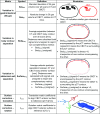Image guidance and interfractional anatomical variation in paediatric abdominal radiotherapy
- PMID: 37102707
- PMCID: PMC10230397
- DOI: 10.1259/bjr.20230058
Image guidance and interfractional anatomical variation in paediatric abdominal radiotherapy
Abstract
Objectives: To identify variables predicting interfractional anatomical variations measured with cone-beam CT (CBCT) throughout abdominal paediatric radiotherapy, and to assess the potential of surface-guided radiotherapy (SGRT) to monitor these changes.
Methods: Metrics of variation in gastrointestinal (GI) gas volume and separation of the body contour and abdominal wall were calculated from 21 planning CTs and 77 weekly CBCTs for 21 abdominal neuroblastoma patients (median 4 years, range: 2 - 19 years). Age, sex, feeding tubes, and general anaesthesia (GA) were explored as predictive variables for anatomical variation. Furthermore, GI gas variation was correlated with changes in body and abdominal wall separation, as well as simulated SGRT metrics of translational and rotational corrections between CT/CBCT.
Results: GI gas volumes varied 74 ± 54 ml across all scans, while body and abdominal wall separation varied 2.0 ± 0.7 mm and 4.1 ± 1.5 mm from planning, respectively. Patients < 3.5 years (p = 0.04) and treated under GA (p < 0.01) experienced greater GI gas variation; GA was the strongest predictor in multivariate analysis (p < 0.01). Absence of feeding tubes was linked to greater body contour variation (p = 0.03). GI gas variation correlated with body (R = 0.53) and abdominal wall (R = 0.63) changes. The strongest correlations with SGRT metrics were found for anterior-posterior translation (R = 0.65) and rotation of the left-right axis (R = -0.36).
Conclusions: Young age, GA, and absence of feeding tubes were linked to stronger interfractional anatomical variation and are likely indicative of patients benefiting from adaptive/robust planning pathways. Our data suggest a role for SGRT to inform the need for CBCT at each treatment fraction in this patient group.
Advances in knowledge: This is the first study to suggest the potential role of SGRT for the management of internal interfractional anatomical variation in paediatric abdominal radiotherapy.
Figures





Similar articles
-
Comparing Interfractional Stability of Heart Dose Among Three Breath-Hold Radiotherapy Techniques in Breast Cancer.Clin Oncol (R Coll Radiol). 2025 Feb;38:103699. doi: 10.1016/j.clon.2024.103699. Epub 2024 Nov 26. Clin Oncol (R Coll Radiol). 2025. PMID: 39706141
-
Interfractional variation in whole-breast VMAT irradiation: a dosimetric study with complementary SGRT and CBCT patient setup.Radiat Oncol. 2024 Feb 13;19(1):21. doi: 10.1186/s13014-024-02418-5. Radiat Oncol. 2024. PMID: 38347554 Free PMC article.
-
Evaluation of interfractional variation of the centroid position and volume of internal target volume during stereotactic body radiotherapy of lung cancer using cone-beam computed tomography.J Appl Clin Med Phys. 2016 Mar 8;17(2):461-472. doi: 10.1120/jacmp.v17i2.5835. J Appl Clin Med Phys. 2016. PMID: 27074466 Free PMC article.
-
Target volume motion during anal cancer image guided radiotherapy using cone-beam computed tomography.Br J Radiol. 2018 May;91(1085):20170654. doi: 10.1259/bjr.20170654. Epub 2018 Mar 6. Br J Radiol. 2018. PMID: 29393674 Free PMC article.
-
Recent advanced in Surface Guided Radiation Therapy.Radiat Oncol. 2020 Jul 31;15(1):187. doi: 10.1186/s13014-020-01629-w. Radiat Oncol. 2020. PMID: 32736570 Free PMC article. Review.
Cited by
-
Surface guided radiotherapy practice in paediatric oncology: a survey on behalf of the SIOPE Radiation Oncology Working Group.Br J Radiol. 2024 May 7;97(1157):1044-1049. doi: 10.1093/bjr/tqae049. Br J Radiol. 2024. PMID: 38445717 Free PMC article.
-
Radiation exposure of young patients with abdominal neuroblastoma from therapeutic and imaging procedures: a phantom study.Phys Eng Sci Med. 2025 Jul 22. doi: 10.1007/s13246-025-01601-6. Online ahead of print. Phys Eng Sci Med. 2025. PMID: 40694233
-
Paediatric radiotherapy in the United Kingdom: an evolving subspecialty and a paradigm for integrated teamworking in oncology.Br J Radiol. 2024 Jan 23;97(1153):21-30. doi: 10.1093/bjr/tqad028. Br J Radiol. 2024. PMID: 38263828 Free PMC article.
-
Unsupervised Deep Learning for Synthetic CT Generation from CBCT Images for Proton and Carbon Ion Therapy for Paediatric Patients.Sensors (Basel). 2024 Nov 22;24(23):7460. doi: 10.3390/s24237460. Sensors (Basel). 2024. PMID: 39685997 Free PMC article.
References
-
- Public health England. children, teenagers and young adults UK cancer statistics report. 2021. Available from: http://www.ncin.org.uk/cancer_type_and_topic_specific_work/cancer_type_s...
MeSH terms
Grants and funding
LinkOut - more resources
Full Text Sources
Research Materials

